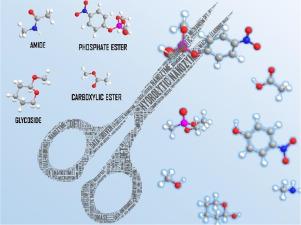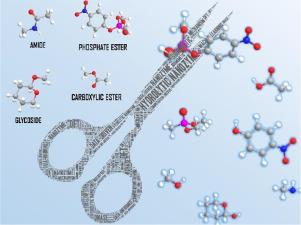Leveraging mechanistic insight to design hydrolytic nanozymes
IF 20.3
1区 化学
Q1 CHEMISTRY, INORGANIC & NUCLEAR
引用次数: 0
Abstract
Hydrolytic nanozymes have emerged as promising candidates for diverse applications across pharmaceuticals, chemicals, environmental remediation, food, and paper industries. Despite their potential, research on hydrolytic nanozymes remains significantly underdeveloped, accounting for only 14.4 % of all nanozyme studies (1256 papers out of 8737). A critical gap exists in understanding the catalytic mechanisms and design strategies of these nanozymes, hindering their theoretical advancement and practical utilization. This review aims to address this gap by systematically organizing and summarizing the catalytic mechanisms of hydrolytic nanozymes, categorized by structural composition and substrate type, along with the design approaches ranging from biomimetic strategies to the cutting-edge data-driven methods, providing theoretical insights to guide the rational design and efficient development of hydrolytic nanozymes. Furthermore, this review offers perspectives on the future prospects and challenges in the field, aiming to inspire further research and innovation in this rapidly advancing area.


利用机理洞察力设计水解纳米酶
水解纳米酶已成为制药、化工、环境修复、食品和造纸等行业各种应用的有前途的候选物质。尽管水解纳米酶潜力巨大,但其研究仍严重不足,仅占所有纳米酶研究的 14.4%(8737 篇论文中的 1256 篇)。在了解这些纳米酶的催化机理和设计策略方面存在着严重的差距,阻碍了它们的理论进步和实际应用。本综述旨在弥补这一空白,系统地整理和总结了水解纳米酶的催化机理(按结构组成和底物类型分类),以及从仿生策略到前沿数据驱动方法的设计方法,为指导水解纳米酶的合理设计和高效开发提供理论依据。此外,这篇综述还对该领域的未来前景和挑战进行了展望,旨在激发这一快速发展领域的进一步研究和创新。
本文章由计算机程序翻译,如有差异,请以英文原文为准。
求助全文
约1分钟内获得全文
求助全文
来源期刊

Coordination Chemistry Reviews
化学-无机化学与核化学
CiteScore
34.30
自引率
5.30%
发文量
457
审稿时长
54 days
期刊介绍:
Coordination Chemistry Reviews offers rapid publication of review articles on current and significant topics in coordination chemistry, encompassing organometallic, supramolecular, theoretical, and bioinorganic chemistry. It also covers catalysis, materials chemistry, and metal-organic frameworks from a coordination chemistry perspective. Reviews summarize recent developments or discuss specific techniques, welcoming contributions from both established and emerging researchers.
The journal releases special issues on timely subjects, including those featuring contributions from specific regions or conferences. Occasional full-length book articles are also featured. Additionally, special volumes cover annual reviews of main group chemistry, transition metal group chemistry, and organometallic chemistry. These comprehensive reviews are vital resources for those engaged in coordination chemistry, further establishing Coordination Chemistry Reviews as a hub for insightful surveys in inorganic and physical inorganic chemistry.
 求助内容:
求助内容: 应助结果提醒方式:
应助结果提醒方式:


